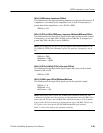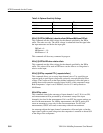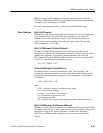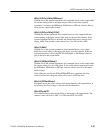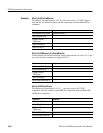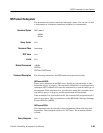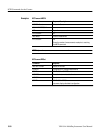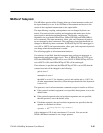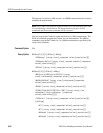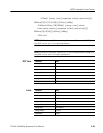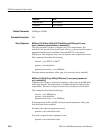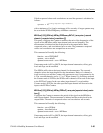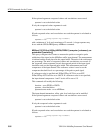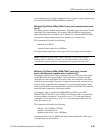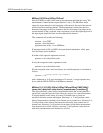
SCPI Commands for the Counter
VX4101A MultiPaq Instrument User Manual
3–91
MEASure? Subsystem
The MEASure queries tell the Counter what type of measurement to make and
the input channel(s) to use. It also INITiates a measurement and moves to the
results of the completed measurement to the output buffer.
The input filtering, coupling, and impedance are not changed by these com-
mands. You must select the coupling and impedance that make sense for the
input signal(s) and the desired measurement. The filtering, coupling and
impedance are set with the INPut:FILter, INPut:COUPling and INPut:IMPed-
ance commands. The input attenuation, offset, gain, and comparator hysteresis
are not changed by these commands. The comparator slopes and thresholds are
changed to defaults by these commands. If INPut:SETup:AUTO (autotrigger) is
set to ON or ONCE, the input attenuation, offset, gain, and comparator hysteresis
can change when the measurement is started.
The following applies to all measurement functions:
If a reference is specified, then the instrument must perform an autotrigger to
determine the appropriate trigger levels. Thus, if INPut:SETup:AUTO is set to
OFF, then INPut:SETup:AUTO will be set to ONCE. If INPut:SETup:AUTO is
set to ONCE or ON, then INPut:SETup:AUTO will be unchanged.
If no reference is specified and the INPut:SETup:AUTO is set to OFF, then the
counter front end will be changed to the following:
gain is set to 1
attenuation is set to 1
threshold is set to 0 V for frequency, period, and totalize and to –0.03 V for
all other measurement functions (so that the upper threshold of the hysteresis
is set to 0 V)
The aperture is set for all measurement commands except for totalize as follows:
H If the optional resolution argument is not specified, then aperture is set to the
default value.
H If the optional expected value and resolution arguments are not specified,
then the aperture is set to the default value.
H If both the expected value and resolution arguments are specified, then the
aperture is calculated as follows:
aperture + 10
(–9)logtexpectedu*logtresolutionu)
with a minimum of 1E–8 and a maximum of 5 seconds. You can use the
SENSe:APERture command to set a longer aperture.



